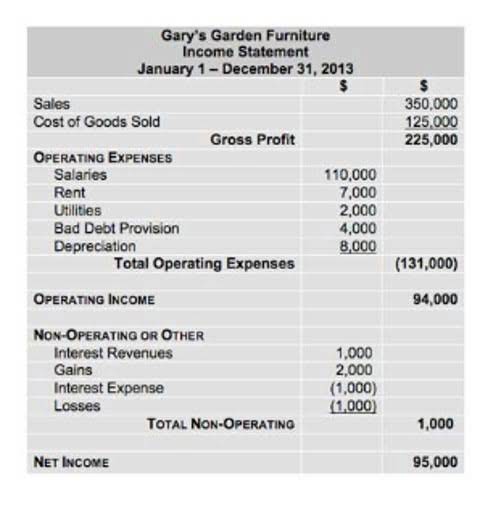Bookkeeping
Debits and credits Wikipedia
This double-entry T-account example ensures the accounting equation stays balanced, with total debits equal to total credits. T-accounts can also be used to record changes to a company income statement, where revenues (profits) and expenses (losses) are recorded. If you want to review debits and credits, see the lesson on debits and credits. And for a review of the most common journal entries, see the lesson on basic accounting journal entries. When working with T-accounts and general ledger accounts, the term contra account that will evidently come up. A contra account is an asset account there is a credit balance where the normal balance would be a debit.
📊 Master Excel & Finance SkillsJoin 100K+ Learners⚡Up to 80% OFF!Instructor: Dheeraj Vaidya, CFA, FRM
T-accounts are used to track individual account balances and transactions, while trial balance summaries are used https://travelplugkenya.co.ke/2022/07/29/what-is-the-cash-flow-from-operation-ratio-cfo/ to ensure the overall accuracy of a company’s financial records. A balance sheet summarizes a company’s financial position at a point in time, detailing assets, liabilities, and equity. T-Accounts are a fundamental tool in accounting used to visually represent and organize financial transactions. T accounts make it easier to manage a double-entry bookkeeping system.
- With automation handling the heavy lifting, accountants can shift their focus to the bigger picture.
- The asset Equipment increases by $2,500 and is recorded as a debit.
- A liability account on the books of a company receiving cash in advance of delivering goods or services to the customer.
- With these benefits, T-Accounts prove to be a valuable tool in the world of accounting and bookkeeping.
- Analysts use T account data to assess trends, identify patterns, and make informed decisions about an organization’s financial performance.
- While T-accounts help visualize transaction flow, ledgers are the authoritative source used in reports and audits.
How Are T Accounts Used in Accounting?
- T-accounts can become unwieldy and inefficient in large-scale operations, such as those of multinational corporations or conglomerates.
- From the bank’s point of view, when a debit card is used to pay a merchant, the payment causes a decrease in the amount of money the bank owes to the cardholder.
- Journal entries are the official, chronological records of all financial transactions.
- T accounts are one of the primary forms of performing double-entry accounting.
- With the outstanding bill paid, accounts payable account is debited by £700, reducing its value and showing that there is no more money owed.
- The general ledger is divided up into individual accounts which categorise similar transaction types together.
They’re typically used for learning, troubleshooting, or quick analysis. For asset accounts, which include cash, accounts receivable, inventory, PP&E, and others, the left side of the T Account (debit side) is always an increase to the account. The right side (credit side) is conversely, a decrease to the asset account. For liabilities and equity accounts, however, debits always signify a decrease to the account, while credits always signify an increase to the account. The top of the T is used as a heading for the name of the account to identify the account, which is the category for the transaction being recorded like supplies, rent, etc. Below the heading, the left side or debit side is used for debit entries and the right side or credit side is for credit entries.
The Ethics of Overpromising Cost Savings to Investors
- A balance sheet is a summary of a company’s financial position at a given point in time.
- If the revenues earned are a main activity of the business, they are considered to be operating revenues.
- Despite these challenges, T-accounts remain an essential learning tool and a useful way to visualise complex accounting concepts.
- From accountants and entrepreneurs to students and investors, understanding T-accounts empowers individuals to make informed financial decisions and confidently navigate the world of money.
- One T account example is; when something is purchased for the company, it could either be categorized as an expense or as a capital cost.
- Sometimes you will see debit and credit labeled as dr and cr respectively.
“Debit this,” they’d say, “credit that.” It all felt like an ancient accounting ritual. One is to teach accounting since it depicts the flow of transactions through the accounts in which they are maintained in a transparent manner. For the same reason, a second use is to clarify more challenging accounting operations. Whether you’re doing manual or electronic accounting for your small business, you should make T-accounts a habit to double-check your financial standing. Deeply comprehending T accounts can help you extract information like the nature of a particular transaction and the movement of each account.
Debtors (or Receivables) Ledger
- Now, every business has its own chart of accounts that depends on the industry they are a part of and the financial activities they lead.
- While T-accounts provide a basic framework for recording transactions, they offer limited analytical capabilities for decision support.
- However, for liabilities and equity accounts, debits always represent a drop in the account, whereas credits always represent a rise.
- Likewise, accounts with a credit balance, like liabilities, will always increase when another credit is added to the account.
- T accounts are a simple and convenient way to organize your journals for basic bookkeeping functions.
- A general ledger offers comprehensive documentation of all financial transactions of the company over a certain period.
- As you can see, assets and expenses have normal balances on the left, while liabilities, revenue, and owner’s equity have normal balances on the right.
On the other hand, credits would reduce expenses (not very common) – this could happen if you return supplies to a vendor and get a credit (reducing the expense). These are the things your business owns, like cash, inventory, equipment, and buildings. Debits here make sense because they represent adding value, like buying new equipment (debit) which increases the total value of your assets. Conversely, credits mean you’re selling something (debiting cash) and reducing the total asset value.
How to record the T-accounts
A general ledger offers comprehensive documentation of all financial transactions of the company over a certain period. A general ledger is the repository of all account-related information t account definition required to prepare a financial statement. The typical accounts include accounts of assets, liabilities, shareholders’ equity, revenues, and expenses, etc.
🧾financial accounting i review
For liabilities and equity accounts, the debits indicate a decrease to the account and a credit indicates an increase to the account. A T account is the visual representation of accounts in the form of the alphabet T. The left side of the T is always used to record the debit transactions while the right side records the credit transactions. The debits and credits are separated by Retail Accounting the vertical line of the T. This makes it visually easier to track the debits and credits or in other words the additions and subtractions to each account.
The Importance of T-Accounts in the Accounting Process
Debit amounts are entered on the left side of the “T” and credit amounts are entered on the right side. Having the simple T account structure makes it very easy for the person who is recording the transaction to make two corresponding entries in the books. It makes the recorded information easier to understand at a glance.
In today’s dynamic business environment, stakeholders demand comprehensive insights to drive strategic decisions and optimize performance. Small business owners, accountants, or bookkeepers accustomed to double-entry-style accounting use this tool, which can serve as a powerful graphic aid to ensure accounts balance out. If transactions are recorded incorrectly in a T-account, the mistake carries over to financial reports. This prepaid £6,000 represents an asset because the landlord owes the business 3 months usage of their property rent has been paid in advance. As the business will be paying for the coffee machine in the following month, the accounts payable is increased (credited) by £700.





